Lei Jiao
An All-digital 65-nm Tsetlin Machine Image Classification Accelerator with 8.6 nJ per MNIST Frame at 60.3k Frames per Second
Jan 31, 2025



Abstract:We present an all-digital programmable machine learning accelerator chip for image classification, underpinning on the Tsetlin machine (TM) principles. The TM is a machine learning algorithm founded on propositional logic, utilizing sub-pattern recognition expressions called clauses. The accelerator implements the coalesced TM version with convolution, and classifies booleanized images of 28$\times$28 pixels with 10 categories. A configuration with 128 clauses is used in a highly parallel architecture. Fast clause evaluation is obtained by keeping all clause weights and Tsetlin automata (TA) action signals in registers. The chip is implemented in a 65 nm low-leakage CMOS technology, and occupies an active area of 2.7mm$^2$. At a clock frequency of 27.8 MHz, the accelerator achieves 60.3k classifications per second, and consumes 8.6 nJ per classification. The latency for classifying a single image is 25.4 $\mu$s which includes system timing overhead. The accelerator achieves 97.42%, 84.54% and 82.55% test accuracies for the datasets MNIST, Fashion-MNIST and Kuzushiji-MNIST, respectively, matching the TM software models.
Scalable Multi-phase Word Embedding Using Conjunctive Propositional Clauses
Jan 31, 2025



Abstract:The Tsetlin Machine (TM) architecture has recently demonstrated effectiveness in Machine Learning (ML), particularly within Natural Language Processing (NLP). It has been utilized to construct word embedding using conjunctive propositional clauses, thereby significantly enhancing our understanding and interpretation of machine-derived decisions. The previous approach performed the word embedding over a sequence of input words to consolidate the information into a cohesive and unified representation. However, that approach encounters scalability challenges as the input size increases. In this study, we introduce a novel approach incorporating two-phase training to discover contextual embeddings of input sequences. Specifically, this method encapsulates the knowledge for each input word within the dataset's vocabulary, subsequently constructing embeddings for a sequence of input words utilizing the extracted knowledge. This technique not only facilitates the design of a scalable model but also preserves interpretability. Our experimental findings revealed that the proposed method yields competitive performance compared to the previous approaches, demonstrating promising results in contrast to human-generated benchmarks. Furthermore, we applied the proposed approach to sentiment analysis on the IMDB dataset, where the TM embedding and the TM classifier, along with other interpretable classifiers, offered a transparent end-to-end solution with competitive performance.
Adversarial Attacks on AI-Generated Text Detection Models: A Token Probability-Based Approach Using Embeddings
Jan 31, 2025



Abstract:In recent years, text generation tools utilizing Artificial Intelligence (AI) have occasionally been misused across various domains, such as generating student reports or creative writings. This issue prompts plagiarism detection services to enhance their capabilities in identifying AI-generated content. Adversarial attacks are often used to test the robustness of AI-text generated detectors. This work proposes a novel textual adversarial attack on the detection models such as Fast-DetectGPT. The method employs embedding models for data perturbation, aiming at reconstructing the AI generated texts to reduce the likelihood of detection of the true origin of the texts. Specifically, we employ different embedding techniques, including the Tsetlin Machine (TM), an interpretable approach in machine learning for this purpose. By combining synonyms and embedding similarity vectors, we demonstrates the state-of-the-art reduction in detection scores against Fast-DetectGPT. Particularly, in the XSum dataset, the detection score decreased from 0.4431 to 0.2744 AUROC, and in the SQuAD dataset, it dropped from 0.5068 to 0.3532 AUROC.
Pruning Literals for Highly Efficient Explainability at Word Level
Nov 07, 2024



Abstract:Designing an explainable model becomes crucial now for Natural Language Processing(NLP) since most of the state-of-the-art machine learning models provide a limited explanation for the prediction. In the spectrum of an explainable model, Tsetlin Machine(TM) is promising because of its capability of providing word-level explanation using proposition logic. However, concern rises over the elaborated combination of literals (propositional logic) in the clause that makes the model difficult for humans to comprehend, despite having a transparent learning process. In this paper, we design a post-hoc pruning of clauses that eliminate the randomly placed literals in the clause thereby making the model more efficiently interpretable than the vanilla TM. Experiments on the publicly available YELP-HAT Dataset demonstrate that the proposed pruned TM's attention map aligns more with the human attention map than the vanilla TM's attention map. In addition, the pairwise similarity measure also surpasses the attention map-based neural network models. In terms of accuracy, the proposed pruning method does not degrade the accuracy significantly but rather enhances the performance up to 4% to 9% in some test data.
* 8 pages, 3 figures
Low-Latency Video Anonymization for Crowd Anomaly Detection: Privacy vs. Performance
Oct 24, 2024



Abstract:Recent advancements in artificial intelligence promise ample potential in monitoring applications with surveillance cameras. However, concerns about privacy and model bias have made it challenging to utilize them in public. Although de-identification approaches have been proposed in the literature, aiming to achieve a certain level of anonymization, most of them employ deep learning models that are computationally demanding for real-time edge deployment. In this study, we revisit conventional anonymization solutions for privacy protection and real-time video anomaly detection (VAD) applications. We propose a novel lightweight adaptive anonymization for VAD (LA3D) that employs dynamic adjustment to enhance privacy protection. We evaluated the approaches on publicly available privacy and VAD data sets to examine the strengths and weaknesses of the different anonymization techniques and highlight the promising efficacy of our approach. Our experiment demonstrates that LA3D enables substantial improvement in the privacy anonymization capability without majorly degrading VAD efficacy.
Exploring State Space and Reasoning by Elimination in Tsetlin Machine
Jul 12, 2024Abstract:The Tsetlin Machine (TM) has gained significant attention in Machine Learning (ML). By employing logical fundamentals, it facilitates pattern learning and representation, offering an alternative approach for developing comprehensible Artificial Intelligence (AI) with a specific focus on pattern classification in the form of conjunctive clauses. In the domain of Natural Language Processing (NLP), TM is utilised to construct word embedding and describe target words using clauses. To enhance the descriptive capacity of these clauses, we study the concept of Reasoning by Elimination (RbE) in clauses' formulation, which involves incorporating feature negations to provide a more comprehensive representation. In more detail, this paper employs the Tsetlin Machine Auto-Encoder (TM-AE) architecture to generate dense word vectors, aiming at capturing contextual information by extracting feature-dense vectors for a given vocabulary. Thereafter, the principle of RbE is explored to improve descriptivity and optimise the performance of the TM. Specifically, the specificity parameter s and the voting margin parameter T are leveraged to regulate feature distribution in the state space, resulting in a dense representation of information for each clause. In addition, we investigate the state spaces of TM-AE, especially for the forgotten/excluded features. Empirical investigations on artificially generated data, the IMDB dataset, and the 20 Newsgroups dataset showcase the robustness of the TM, with accuracy reaching 90.62\% for the IMDB.
Exploring Effects of Hyperdimensional Vectors for Tsetlin Machines
Jun 04, 2024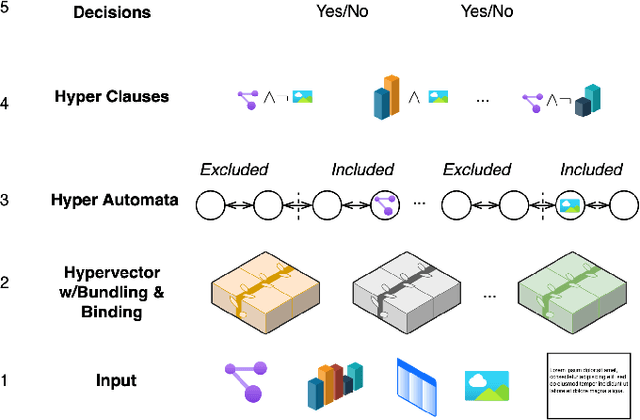
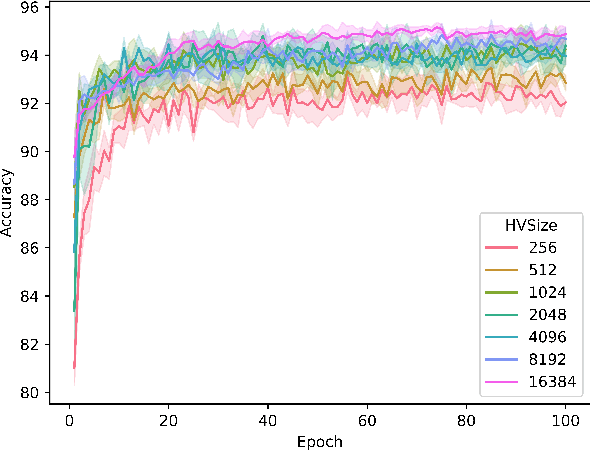
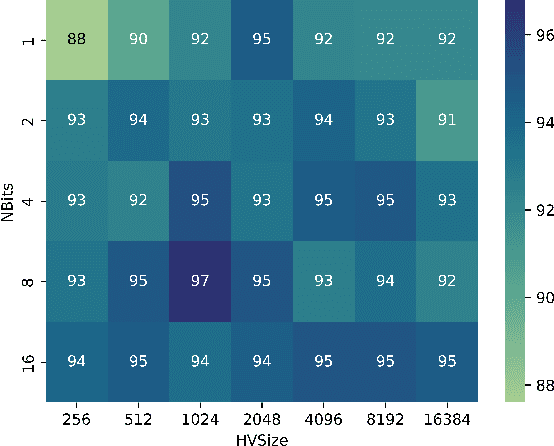
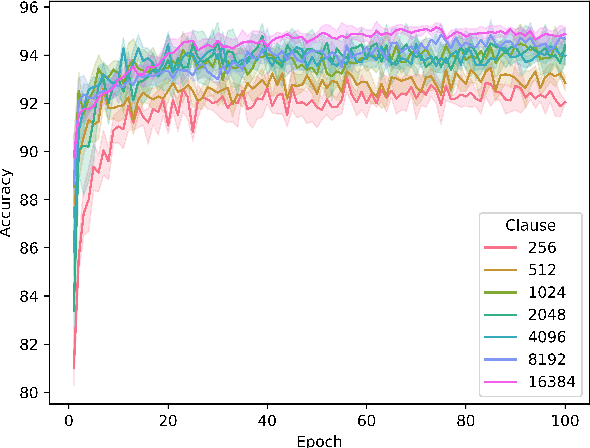
Abstract:Tsetlin machines (TMs) have been successful in several application domains, operating with high efficiency on Boolean representations of the input data. However, Booleanizing complex data structures such as sequences, graphs, images, signal spectra, chemical compounds, and natural language is not trivial. In this paper, we propose a hypervector (HV) based method for expressing arbitrarily large sets of concepts associated with any input data. Using a hyperdimensional space to build vectors drastically expands the capacity and flexibility of the TM. We demonstrate how images, chemical compounds, and natural language text are encoded according to the proposed method, and how the resulting HV-powered TM can achieve significantly higher accuracy and faster learning on well-known benchmarks. Our results open up a new research direction for TMs, namely how to expand and exploit the benefits of operating in hyperspace, including new booleanization strategies, optimization of TM inference and learning, as well as new TM applications.
Contracting Tsetlin Machine with Absorbing Automata
Oct 17, 2023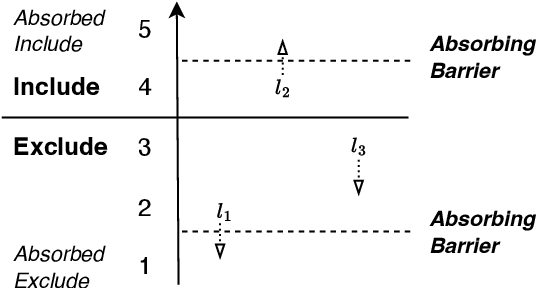
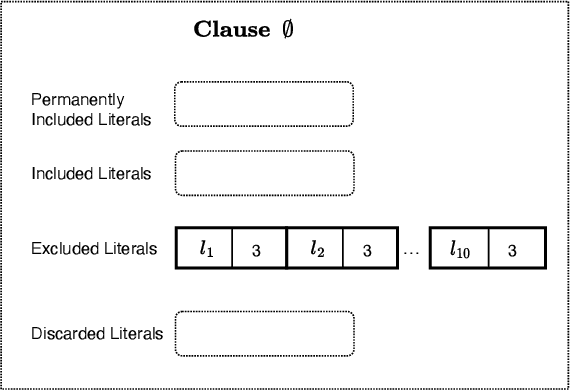
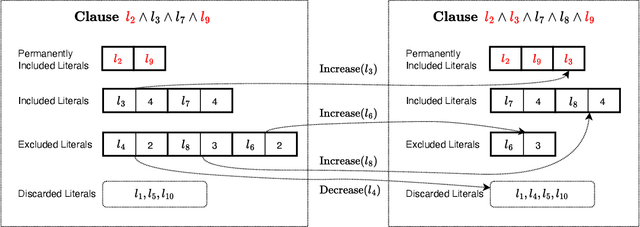
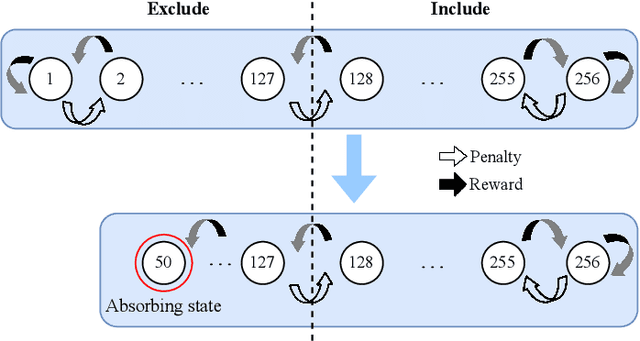
Abstract:In this paper, we introduce a sparse Tsetlin Machine (TM) with absorbing Tsetlin Automata (TA) states. In brief, the TA of each clause literal has both an absorbing Exclude- and an absorbing Include state, making the learning scheme absorbing instead of ergodic. When a TA reaches an absorbing state, it will never leave that state again. If the absorbing state is an Exclude state, both the automaton and the literal can be removed from further consideration. The literal will as a result never participates in that clause. If the absorbing state is an Include state, on the other hand, the literal is stored as a permanent part of the clause while the TA is discarded. A novel sparse data structure supports these updates by means of three action lists: Absorbed Include, Include, and Exclude. By updating these lists, the TM gets smaller and smaller as the literals and their TA withdraw. In this manner, the computation accelerates during learning, leading to faster learning and less energy consumption.
Generalized Convergence Analysis of Tsetlin Machines: A Probabilistic Approach to Concept Learning
Oct 03, 2023

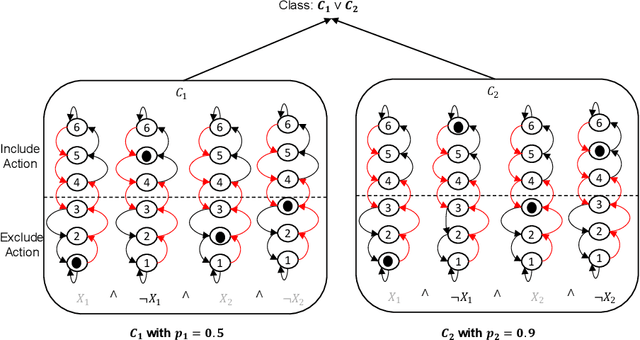
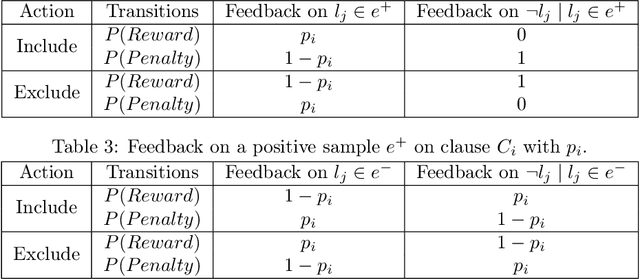
Abstract:Tsetlin Machines (TMs) have garnered increasing interest for their ability to learn concepts via propositional formulas and their proven efficiency across various application domains. Despite this, the convergence proof for the TMs, particularly for the AND operator (\emph{conjunction} of literals), in the generalized case (inputs greater than two bits) remains an open problem. This paper aims to fill this gap by presenting a comprehensive convergence analysis of Tsetlin automaton-based Machine Learning algorithms. We introduce a novel framework, referred to as Probabilistic Concept Learning (PCL), which simplifies the TM structure while incorporating dedicated feedback mechanisms and dedicated inclusion/exclusion probabilities for literals. Given $n$ features, PCL aims to learn a set of conjunction clauses $C_i$ each associated with a distinct inclusion probability $p_i$. Most importantly, we establish a theoretical proof confirming that, for any clause $C_k$, PCL converges to a conjunction of literals when $0.5<p_k<1$. This result serves as a stepping stone for future research on the convergence properties of Tsetlin automaton-based learning algorithms. Our findings not only contribute to the theoretical understanding of Tsetlin Machines but also have implications for their practical application, potentially leading to more robust and interpretable machine learning models.
Learning Minimalistic Tsetlin Machine Clauses with Markov Boundary-Guided Pruning
Sep 12, 2023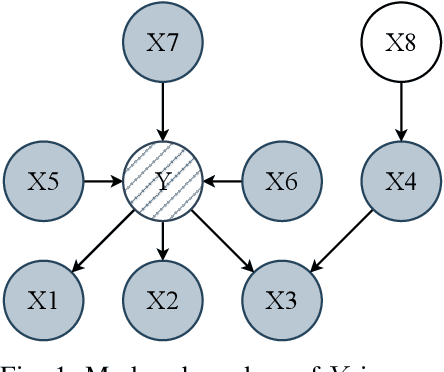


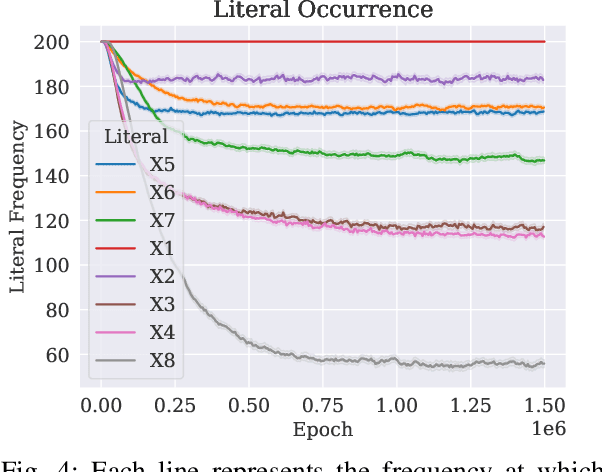
Abstract:A set of variables is the Markov blanket of a random variable if it contains all the information needed for predicting the variable. If the blanket cannot be reduced without losing useful information, it is called a Markov boundary. Identifying the Markov boundary of a random variable is advantageous because all variables outside the boundary are superfluous. Hence, the Markov boundary provides an optimal feature set. However, learning the Markov boundary from data is challenging for two reasons. If one or more variables are removed from the Markov boundary, variables outside the boundary may start providing information. Conversely, variables within the boundary may stop providing information. The true role of each candidate variable is only manifesting when the Markov boundary has been identified. In this paper, we propose a new Tsetlin Machine (TM) feedback scheme that supplements Type I and Type II feedback. The scheme introduces a novel Finite State Automaton - a Context-Specific Independence Automaton. The automaton learns which features are outside the Markov boundary of the target, allowing them to be pruned from the TM during learning. We investigate the new scheme empirically, showing how it is capable of exploiting context-specific independence to find Markov boundaries. Further, we provide a theoretical analysis of convergence. Our approach thus connects the field of Bayesian networks (BN) with TMs, potentially opening up for synergies when it comes to inference and learning, including TM-produced Bayesian knowledge bases and TM-based Bayesian inference.
 Add to Chrome
Add to Chrome Add to Firefox
Add to Firefox Add to Edge
Add to Edge